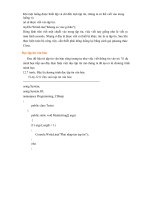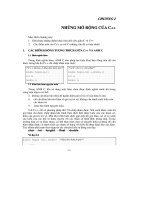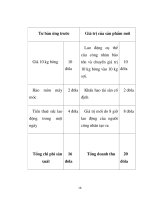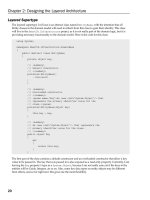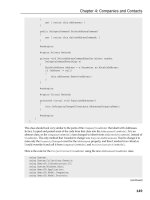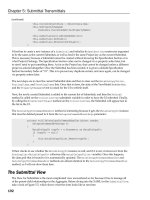NET Domain-Driven Design with C#P roblem – Design – Solution phần 4 doc
Bạn đang xem bản rút gọn của tài liệu. Xem và tải ngay bản đầy đủ của tài liệu tại đây (329.14 KB, 43 trang )
Chapter 3: Managing Projects
106
I promised earlier to show how I was going to deal with the Address Value objects in the XAML code, so
here it goes. I already showed how I am handling this in the
ProjectInformationViewModel , so now
it is time to show it in the XAML:
< Label Margin=”35,69.04,0,0” Content=”Project Address:”
Style=”{StaticResource boldLabelStyle}”/ >
< TextBox Margin=”195,69.15,0,0”
Text=”{Binding Path=ProjectAddress.Street}”
Style=”{StaticResource baseTextBoxStyle}”/ >
< Label Margin=”35,97.04,0,0” Content=”Project City:”
Style=”{StaticResource boldLabelStyle}”/ >
< TextBox Margin=”195,97.15,0,0”
Text=”{Binding Path=ProjectAddress.City}”
Style=”{StaticResource baseTextBoxStyle}”/ >
< Label Margin=”35,125.04,0,0” Content=”Project State:”
Style=”{StaticResource boldLabelStyle}”/ >
< TextBox Margin=”195,125.15,0,0”
Text=”{Binding Path=ProjectAddress.State}”
Style=”{StaticResource baseTextBoxStyle}”/ >
< Label Margin=”35,153.04,0,0” Content=”Project Zip:”
Style=”{StaticResource boldLabelStyle}”/ >
< TextBox Margin=”195,153.15,0,0”
Text=”{Binding Path=ProjectAddress.PostalCode}”
Style=”{StaticResource baseTextBoxStyle}”/ >
The way this works is that I am not actually binding to the CurrentProject property of the
ProjectInformationViewModel ; instead I am binding to the properties of the ProjectAddress
property of the
ProjectInformationViewModel . Remember, the ProjectAddress property is actually
an instance of the
MutableAddress type, so I can change the properties through data binding. The code
inside of the
ProjectInformationViewModel translates this into my immutable Address Value object,
and the data going into the
Address Value object ’ s constructor is validated inside of the constructor in
order to make sure that I am entering a valid address.
I love the fact that I can bind to my ViewModel and get the type of functionality that I just showed in
these examples without having to write any procedural code in my View!
For the sake of brevity, I am not going to show all of the XAML code for the
ProjectInformationView ;
there is just too much. There is nothing really special going on with the rest of it; it is the same pattern as
I showed in Chapter 2 with the
SelectProjectView XAML.
c03.indd 106c03.indd 106 3/18/08 5:13:04 PM3/18/08 5:13:04 PM
Chapter 3: Managing Projects
107
Summary
The end result in the UI is not that spectacular, but I certainly covered a lot of ground in getting there. In
this chapter, I first defined and modeled all of the objects that make up what a Project is and then started
analyzing the classes further in order to define the Aggregate Boundaries. Once the Aggregate
Boundaries were defined, the Aggregate Roots were chosen, and then I defined what the various
repositories were for the Aggregates. After the repositories were designed and implemented, I then
designed and implemented the ViewModel and the View for the use case scenario of editing Projects.
I know it may not sound like much, but I actually wrote a lot of code and refactored a lot of code in the
process of getting to where I am now. The rest of the way should be well - paved for code reuse in the
SmartCA application.
c03.indd 107c03.indd 107 3/18/08 5:13:04 PM3/18/08 5:13:04 PM
c03.indd 108c03.indd 108 3/18/08 5:13:04 PM3/18/08 5:13:04 PM
Companies and Contacts
Last chapter I showed how both Companies and Contacts were part of the Project Aggregate. Since
the focus was on the Project Aggregate, not much was done with these two Entities. This chapter,
I will dive in and take a deeper look at the Company and Contact Aggregates, and I will show how
they relate to the Project Aggregate.
The Problem
One of the problems with the legacy application is that it does not handle tracking Companies,
Contacts, and their associated Addresses very well. The current system does not allow multiple
Addresses per Company or Contact, and as a result the users are often entering the same
Companies and Contacts into the system as duplicate records in order to show a different Address
for the Company or Contact.
With that being said, it sounds like a database issue of having denormalized data. It is not the
point of this book to dwell on the database design; I believe that the focus of the problem needs to
be on the domain model. If the domain model is designed properly, it can handle this problem.
Remember, one of the tenets of Domain - Driven Design, which I discussed in Chapter 2 , is
persistence ignorance . Therefore, the application ’ s data store could be a text file for all I care, because
it is abstracted away by the Repository Framework.
The Design
In the SmartCA domain, the purpose of a Project is to bring together and manage all of the people
involved in the construction process. In the next few sections, I will be designing the domain
model, determining the Project Aggregate and its boundaries, and designing the repository
for Projects.
c04.indd 109c04.indd 109 3/18/08 5:14:11 PM3/18/08 5:14:11 PM
Chapter 4: Companies and Contacts
110
Designing the Domain Model
Companies and Contacts are extremely important in the SmartCA domain, as they ensure that the right
construction documents get to the right people in a timely manner. There is a slight distinction between a
Contact and a ProjectContact. A ProjectContact is a Contact that happens to be part of a Project, whereas
a Contact may or may not be on a Project.
Companies and Contacts both have multiple Addresses, but Companies also must have one of their
Addresses designated as their headquarters address. Figure 4.1 is a diagram showing the relationships
between Companies, Contacts, ProjectContacts, and Addresses.
Headquarters
Address
Address
Project Contact
ContactCompany
**
Figure 4.1: Company and Contact Aggregates.
Each contact belongs to a single Company, but people move around, and therefore Contacts often change
companies over the course of time. You may notice that in this diagram that a ProjectContact contains a
Contact, but does not inherit from a Contact. This is purely my preference to stick with the Gang - of - Four
advice by favoring composition over inheritance.
The Gang - of - Four, also known as GoF, refers to the four authors who wrote the classic
software - engineering book Design Patterns: Elements of Reusable Object - Oriented Software .
The book ’ s authors are Erich Gamma, Richard Helm, Ralph Johnson, and John Vlissides.
Defining the Company and Contact Aggregates
Even though the
Contact class maintains a relationship to the Company class, both the Company class
and the
Contact class are the roots of their own Aggregates, with both containing instances of the
Address Value class. ProjectContact is not the root of an aggregate; it is an Entity, but it actually
belongs to the Project Aggregate (see Figure 4.2 ).
c04.indd 110c04.indd 110 3/18/08 5:14:13 PM3/18/08 5:14:13 PM
Chapter 4: Companies and Contacts
111
Project
Class
EntityBase
Fields
Methods
Properties
ActualCompletionDate
Address
AdjustedCompletionDate
AdjustedConstructionCost
AeChangeOrderAmount
AgencyApplicationNumber
AgencyFileNumber
Allowances
ConstructionAdministrator
Contacts
ContingencyAllowanceAmount
ContractDate
ContractReason
Contracts
CurrentCompletionDate
EstimatedCompletionDate
EstimatedStartDate
Name
Number
OriginalConstructionCost
Owner
PercentComplete
PrincipalInCharge
Remarks
Segment
TestingAllowanceAmount
TotalChangeOrderDays
TotalChangeOrdersAmount
TotalSquareFeet
UtilityAllowanceAmount
Contact
Class
Person
Fields
Methods
Properties
FaxNumber
JobTitle
MobilePhoneNumber
PhoneNumber
Remarks
Project
Addresses
Addresses
Contact
Company
Class
EntityBase
Fields
Methods
Properties
Abbreviation
FaxNumber
Name
PhoneNumber
Remarks
Url
ProjectContact
Class
EntityBase
Fields
Methods
Properties
OnFinalDistribution
Address
Sealed Class
CurrentCompany
HeadquartersAddress
Company Aggregate
Project Aggregate
Contact Aggregate
Figure 4.2: Classes composing the Company and Contact Aggregates.
Defining the Aggregate Boundaries
As mentioned before, both the Company and Contact Aggregates share the
Address class (see Figure 4.3 ).
Since the
Contact class has a Company property, there are two ways to get to a particular company.
The first way is to go to the Company Aggregate, and the second way is to go to the Contact Aggregate,
navigate to a particular Contact, and then from the Contact navigate to a Company via the
CurrentCompany property.
The third Aggregate in the figure is one I have already shown, the Project Aggregate. This time around,
I have refactored the domain model to include the
ProjectContact class as part of the Project
Aggregate and have defined its relationship with the Contact Aggregate to be one of composition.
c04.indd 111c04.indd 111 3/18/08 5:14:13 PM3/18/08 5:14:13 PM
Chapter 4: Companies and Contacts
112
Project
Class
EntityBase
Fields
Methods
Properties
ActualCompletionDate
Address
AdjustedCompletionDate
AdjustedConstructionCost
AeChangeOrderAmount
AgencyApplicationNumber
AgencyFileNumber
Allowances
ConstructionAdministrator
Contacts
ContingencyAllowanceAmount
ContractDate
ContractReason
Contracts
CurrentCompletionDate
EstimatedCompletionDate
EstimatedStartDate
Name
Number
OriginalConstructionCost
Owner
PercentComplete
PrincipalInCharge
Remarks
Segment
TestingAllowanceAmount
TotalChangeOrderDays
TotalChangeOrdersAmount
TotalSquareFeet
UtilityAllowanceAmount
Contact
Class
Person
Fields
Methods
Properties
FaxNumber
JobTitle
MobilePhoneNumber
PhoneNumber
Remarks
Project
Addresses
Addresses
Contact
Company
Class
EntityBase
Fields
Methods
Properties
Abbreviation
FaxNumber
Name
PhoneNumber
Remarks
Url
ProjectContact
Class
EntityBase
Fields
Methods
Properties
OnFinalDistribution
Address
Sealed Class
CurrentCompany
HeadquartersAddress
Company Aggregate
Project Aggregate
Contact Aggregate
Figure 4.3: The Company and Contact Aggregate boundaries.
Designing the Repositories
Following the one repository per Aggregate rule, there are three repositories to look at in this chapter, the
CompanyRepository , the ContactRepository , and last a revised ProjectRepository . Figure 4.4
shows the company and contact repositories.
I did not show the Project Aggregate Repository classes since they are still the same, they will just have
some new behavior added to them.
The ICompanyRepository Interface
The ICompanyRepository interface is the interface to instances of Company Repositories. Because of
the previous refactoring to
IRepository and SqlCeRepositoryBase < T > , the ICompanyRepository is
currently empty. Here is the
ICompanyRepository interface:
using System;
using SmartCA.Infrastructure.RepositoryFramework;
namespace SmartCA.Model.Companies
{
public interface ICompanyRepository : IRepository < Company >
{
}
}
c04.indd 112c04.indd 112 3/18/08 5:14:13 PM3/18/08 5:14:13 PM
Chapter 4: Companies and Contacts
113
SqlCeRepositoryBase<T>
GenericAbstractClass
RepositoryBase<T>
IContactRepository
Interface
IRepository<Contact>
IRepository<T>
GenericInterface
ContactRepository
Class
SqlCeRepositoryBase<Contact>
IContactRepository
SqlCeRepositoryBase<T>
GenericAbstractClass
RepositoryBase<T>
ICompanyRepository
Interface
IRepository<Company>
IRepository<T>
GenericInterface
CompanyRepository
Class
SqlCeRepositoryBase<Company>
ICompanyRepository
Figure 4.4: The Company and Contact Aggregate Repositories.
The IContactRepository Interface
Just like the ICompanyRepository interface, the IContactRepository interface is also empty. Here is
the
IContactRepository interface:
using System;
using SmartCA.Infrastructure.RepositoryFramework;
namespace SmartCA.Model.Companies
{
public interface IContactRepository : IRepository < Contact >
{
}
}
The IProjectRepository Interface Revisited
The IProjectRepository interface has a new method added to it in order to support ProjectContacts:
using System;
using System.Collections.Generic;
using SmartCA.Infrastructure.RepositoryFramework;
namespace SmartCA.Model.Projects
{
public interface IProjectRepository : IRepository < Project >
(continued)
c04.indd 113c04.indd 113 3/18/08 5:14:13 PM3/18/08 5:14:13 PM
Chapter 4: Companies and Contacts
114
{
IList < Project > FindBy(IList < MarketSegment > segments, bool completed);
Project FindBy(string projectNumber);
IList < MarketSegment > FindAllMarketSegments();
void SaveContact(ProjectContact contact);
}
}
The new method added is SaveContact , which takes an instance of the ProjectContact class as its
argument. You may be wondering where a
FindProjectContacts method is, but the fact that
ProjectContact is not an Aggregate Root and is part of the Project Aggregate means that I must
traverse to
ProjectContact instances from the Project Entity root. This is because the ProjectContact
class is just an Entity in the Project Aggregate; it is not its own Aggregate Root.
Writing the Unit Tests
Just as in the last chapter, before implementing the solution for managing Companies and Contacts, I am
first going to write some unit tests of what I expect of the Company and Contact Repository
implementations. It is important to remember that these tests will compile correctly, but they will also
fail when run, and that is what I expect. They will pass once I write the code for the Repository
implementations in the Solution section.
The ICompanyRepository Unit Tests
I have already created the CompanyRepositoryTest class for the ICompanyRepository unit tests. I am not
going to go over the steps of creating this class, as I covered that in Chapter 3 . I am not going to show how
I created the instance of the
ICompanyRepository interface either, as that is explained in the previous chapter.
Since the
ICompanyRepository interface has no methods in it, and since it does extend the
IRepository < Company > interface, I am going to test the methods from the IRepository < Company >
interface.
The FindByKeyTest Method
The purpose of this test is to verify that I can query the IProjectRepository interface for all Projects
that match the given Market Segments and have not completed.
/// < summary >
///A test for FindBy(object key)
/// < /summary >
[DeploymentItem(“SmartCA.sdf”), TestMethod()]
public void FindByKeyTest()
{
// Set the Key value
object key = “8b6a05be-6106-45fb-b6cc-b03cfa5ab74b”;
(continued)
c04.indd 114c04.indd 114 3/18/08 5:14:14 PM3/18/08 5:14:14 PM
Chapter 4: Companies and Contacts
115
// Find the Company
Company company = this.repository.FindBy(key);
// Verify the Company’s name
Assert.AreEqual(“My Company”, company.Name);
}
The method first starts out by initializing a unique identifier string value. It then passes that value to the
ICompanyRepository interface instance in order to retrieve a Company with that particular Key value.
Once the Company instance is returned from the repository, the Company ’ s name is validated.
The FindAllTest Method
The purpose of the FindAllTest method is to validate that the correct number of Company instances
have been returned by the Company Repository:
/// < summary >
///A test for FindAll()
/// < /summary >
[DeploymentItem(“SmartCA.sdf”), TestMethod()]
public void FindAllTest()
{
// Get all of the Companies
IList < Company > companies = this.repository.FindAll();
// Make sure there are two
Assert.AreEqual(2, companies.Count);
}
This method is pretty short; it simply gets all of the Company instances and checks the total count. What
is not seen here is that when the
ICompanyRepository interface is implemented, it will test the ability
of the repository to map the data correctly from the data store into Company instances. Later in the
chapter, when the
ICompanyRepository interface is implemented, I can run the test again to see what
I messed up when the test fails.
The AddTest Method
The purpose of the AddTest method is to test adding a new Company to the Company Repository:
/// < summary >
///A test for Add(Company item)
/// < /summary >
[DeploymentItem(“SmartCA.sdf”), TestMethod()]
public void AddTest()
{
// Create a new Company and give it a fake name
Company company = new Company();
company.Name = “My Test Company”;
// Add the Company to the Repository
this.repository.Add(company);
(continued)
c04.indd 115c04.indd 115 3/18/08 5:14:14 PM3/18/08 5:14:14 PM
Chapter 4: Companies and Contacts
116
// Commit the transaction
this.unitOfWork.Commit();
// Reload the Company and verify it’s name
Company savedCompany = this.repository.FindBy(company.Key);
Assert.AreEqual(“My Test Company”, savedCompany.Name);
// Clean up
this.repository.Remove(savedCompany);
this.unitOfWork.Commit();
}
This test is a little bit more involved than the previous tests. It starts out by instantiating a new Company
instance and setting its
Name property. It then tries to add the Company to the repository, and then
commits the transaction by calling the
Commit method on the IUnitOfWork instance.
The
Commit method is important because that method calls back into the Company Repository to tell it
to write the Company ’ s data to the data store.
Once the Company has been saved, it is then reloaded and the Company ’ s
Name property is checked to
verify that the
Add and Commit methods worked properly. The last task that the method needs to
perform is to remove the Company. Removing the Company that was just created leaves the data store
in the same state as it was in before the method started, which is important for the rest of the tests that
may depend on a known state of the data store. Otherwise, some of the other tests may fail because there
was data in the data store that was not expected.
The UpdateTest Method
The purpose of the UpdateTest method is to find a Company and update it with a different name, and
then verify that the change was persisted properly:
/// < summary >
///A test for Updating a Company
/// < /summary >
[DeploymentItem(“SmartCA.sdf”), TestMethod()]
public void UpdateTest()
{
// Set the Key value
object key = “59427e22-0c9e-4821-95d6-9c9f541bf37a”;
// Find the Company
Company company = this.repository.FindBy(key);
// Change the Company’s Name
company.Name = “My Updated Company”;
// Update the Repository
this.repository[company.Key] = company;
(continued)
c04.indd 116c04.indd 116 3/18/08 5:14:15 PM3/18/08 5:14:15 PM
Chapter 4: Companies and Contacts
117
// Commit the transaction
this.unitOfWork.Commit();
// Verify that the change was saved
Company savedCompany = this.repository.FindBy(company.Key);
Assert.AreEqual(“My Updated Company”, savedCompany.Name);
}
The first few lines of the method should look familiar; I am just using the same Key value I used before
to find a Company. Once I have found the Company, I then change its
Name property, and then call the
indexer method of the
ICompanyRepository . After the call to the indexer, I use the IUnitOfWork
interface to commit the transaction. Last, I verify that the change actually made it to the data store by
reloading the same Company and checking to see whether its
Name property value is the same one that
I just assigned earlier in the method.
The RemoveTest Method
The purpose of the RemoveTest method is to test the process of removing a Company from the
data store:
/// < summary >
///A test for Remove(Company item)
/// < /summary >
[DeploymentItem(“SmartCA.sdf”), TestMethod()]
public void RemoveTest()
{
// Set the Key value
object key = “8b6a05be-6106-45fb-b6cc-b03cfa5ab74b”;
// Find the Company
Company company = this.repository.FindBy(key);
// Remove the Company from the Repository
this.repository.Remove(company);
// Commit the transaction
this.unitOfWork.Commit();
// Verify that there is now one less Company in the data store
IList < Company > companies = this.repository.FindAll();
Assert.AreEqual(1, companies.Count);
}
Again, the first few lines of the method should look familiar; I am just using the same Key value I used
before to find a Company. Once I have found the Company, I remove it from the repository. After
removing it from the repository, I then use the
IUnitOfWork interface to commit the transaction. Last,
I verify that the change actually made it to the data store by using the repository to find all of the
Company instances and making sure that there is now one fewer Company than before.
c04.indd 117c04.indd 117 3/18/08 5:14:15 PM3/18/08 5:14:15 PM
Chapter 4: Companies and Contacts
118
The IContactRepository Unit Tests
Since the IContactRepository is identical to the ICompanyRepository in that it does not implement
any new methods, I have decided not to show any of the unit test code for it. Its test class will have all of
the exact same methods tested as the
ICompanyRepository test class, only the Entity being passed
around will be a Contact instead of a Company.
The IProjectRepository Unit Test
Since the IProjectRepository has been refactored with a new method, the SaveContact method,
I will only unit test that method.
I have created a new method in the
ProjectRepositoryTest class called SaveProjectContactTest .
The purpose of the method is to test creating a new
ProjectContact instance that is then saved to the
IProjectRepository instance.
/// < summary >
///A test for SaveContact(ProjectContact contact)
/// < /summary >
[DeploymentItem(“SmartCA.sdf”), TestMethod()]
public void SaveProjectContactTest()
{
// The Project Number
string projectNumber = “12345.00”;
// Try to get the Project
Project project = this.repository.FindBy(projectNumber);
// Get the old count of Project Contacts
int oldCount = project.Contacts.Count;
// Get a Contact
IContactRepository contactRepository =
RepositoryFactory.GetRepository < IContactRepository, Contact > ();
object contactKey = “cae9eb86-5a86-4965-9744-18326fd56a3b”;
Contact contact = contactRepository.FindBy(contactKey);
// Create a Project Contact
ProjectContact projectContact = new ProjectContact(project,
Guid.NewGuid(), contact);
// Save the Project Contact
this.repository.SaveContact(projectContact);
// Commit the transaction
this.unitOfWork.Commit();
// Reload the the Project
Project updatedProject = this.repository.FindBy(“12345.00”);
// Verify that there is a new ProjectContact now
Assert.AreEqual(oldCount, updatedProject.Contacts.Count - 1);
}
c04.indd 118c04.indd 118 3/18/08 5:14:15 PM3/18/08 5:14:15 PM
Chapter 4: Companies and Contacts
119
The first part of the code should remind you of the test code from the last chapter, where I tested finding
a Project by a
Project Number value. The next step is to get the count of ProjectContact instances
the Project currently contains. Next, I use the
IContactRepository interface instance to find a Contact,
and then I use that contact to create an instance of the
ProjectContact class. Once I have the new
ProjectContact instance, I then save it to the IProjectRepository instance and commit the
transaction on the
IUnitOfWork instance.
Now that the
ProjectContact instance is saved, I will reload the same Project from the repository, and
make sure that the new count of
ProjectContact instances is one more than the old count.
The Solution
The design is in place for the Company and Contact domain models, the Company and Contact
Aggregates have been defined and their boundaries have been determined, and the repositories have
been designed with their associated tests. It is time to start the code implementation. In this section, I
will be implementing these designs, as well as implementing the ViewModel and the View for
Companies and Contacts.
The Company Class
Like the Project class, the Company class does not have any behavior yet. I have already shown the
Company class in Chapter 3 , but now I have added some more properties to it:
using System;
using SmartCA.Infrastructure.DomainBase;
using System.Collections.Generic;
namespace SmartCA.Model.Companies
{
public class Company : EntityBase
{
private string name;
private string abbreviation;
private Address headquartersAddress;
private List < Address > addresses;
private string phoneNumber;
private string faxNumber;
private string url;
private string remarks;
public Company()
: this(null)
{
}
public Company(object key)
: base(key)
(continued)
c04.indd 119c04.indd 119 3/18/08 5:14:16 PM3/18/08 5:14:16 PM
Chapter 4: Companies and Contacts
120
{
this.name = string.Empty;
this.abbreviation = string.Empty;
this.headquartersAddress = null;
this.addresses = new List < Address > ();
this.phoneNumber = string.Empty;
this.faxNumber = string.Empty;
this.url = string.Empty;
this.remarks = string.Empty;
}
public string Name
{
get { return this.name; }
set { this.name = value; }
}
public string Abbreviation
{
get { return this.abbreviation; }
set { this.abbreviation = value; }
}
public Address HeadquartersAddress
{
get { return this.headquartersAddress; }
set
{
if (this.headquartersAddress != value)
{
this.headquartersAddress = value;
if (!this.addresses.Contains(value))
{
this.addresses.Add(value);
}
}
}
}
public IList < Address > Addresses
{
get { return this.addresses; }
}
public string PhoneNumber
{
get { return this.phoneNumber; }
set { this.phoneNumber = value; }
}
public string FaxNumber
(continued)
c04.indd 120c04.indd 120 3/18/08 5:14:16 PM3/18/08 5:14:16 PM
Chapter 4: Companies and Contacts
121
{
get { return this.faxNumber; }
set { this.faxNumber = value; }
}
public string Url
{
get { return this.url; }
set { this.url = value; }
}
public string Remarks
{
get { return this.remarks; }
set { this.remarks = value; }
}
}
}
The interesting thing to note about the Company class is its HeadquartersAddress property. The
address is really just one of its addresses that has been deemed as a headquarters address. In the setter
for this property, I included logic to make sure that the value of the
Address being passed in is actually
contained in the internal list of
Addresses . If it is not present, then the Address is added to the
collection. The rest of the properties of the
Company class are all very straightforward.
I am not going to go into the detail of the constructors of the
Company class; they follow the pattern of
having two constructors, a default constructor and a parameterized constructor containing the Key value
for the instance. Again, as with the
Project class before, this is because sometimes I may need to load
an existing
Company from a data store and sometimes I may be creating a new Company that does not yet
exist in the data store.
The Contact Class
Aside from the names of its properties, the Contact class is almost completely the same as the
Company class:
using System;
using System.Collections.Generic;
using System.Text;
using SmartCA.Model.Companies;
namespace SmartCA.Model.Contacts
{
public class Contact : Person
{
private string jobTitle;
private string email;
private string phoneNumber;
private string mobilePhoneNumber;
private string faxNumber;
private string remarks;
(continued)
c04.indd 121c04.indd 121 3/18/08 5:14:17 PM3/18/08 5:14:17 PM
Chapter 4: Companies and Contacts
122
private Company currentCompany;
private IList < Address > addresses;
public Contact()
: this(null)
{
}
public Contact(object key)
: this(key, null, null)
{
}
public Contact(object key, string firstName, string lastName)
: base(key, firstName, lastName)
{
this.jobTitle = string.Empty;
this.email = string.Empty;
this.phoneNumber = string.Empty;
this.mobilePhoneNumber = string.Empty;
this.faxNumber = string.Empty;
this.remarks = string.Empty;
this.currentCompany = null;
this.addresses = new List < Address > ();
}
public string JobTitle
{
get { return this.jobTitle; }
set { this.jobTitle = value; }
}
public string Email
{
get { return this.email; }
set { this.email = value; }
}
public string PhoneNumber
{
get { return this.phoneNumber; }
set { this.phoneNumber = value; }
}
public string MobilePhoneNumber
{
get { return this.mobilePhoneNumber; }
set { this.mobilePhoneNumber = value; }
}
(continued)
c04.indd 122c04.indd 122 3/18/08 5:14:17 PM3/18/08 5:14:17 PM
Chapter 4: Companies and Contacts
123
public string FaxNumber
{
get { return this.faxNumber; }
set { this.faxNumber = value; }
}
public string Remarks
{
get { return this.remarks; }
set { this.remarks = value; }
}
public Company CurrentCompany
{
get { return this.currentCompany; }
set { this.currentCompany = value; }
}
public IList < Address > Addresses
{
get { return this.addresses; }
}
}
}
The main difference between the Contact and Company classes is that the Contact class ’ s
CurrentCompany property contains a reference to a Company instance. The Company class, however,
does not contain a reference to any
Contact instances.
The ProjectContact Class
As I mentioned before, the ProjectContact class actually contains a Contact instance and then adds
one other property to it to distinguish it as a
ProjectContact :
using System;
using SmartCA.Model.Contacts;
using SmartCA.Infrastructure.DomainBase;
namespace SmartCA.Model.Projects
{
public class ProjectContact : EntityBase
{
private Project project;
private bool onFinalDistributionList;
private Contact contact;
public ProjectContact(Project project, object key,
Contact contact) : base(key)
(continued)
c04.indd 123c04.indd 123 3/18/08 5:14:17 PM3/18/08 5:14:17 PM
Chapter 4: Companies and Contacts
124
{
this.project = project;
this.contact = contact;
this.onFinalDistributionList = false;
}
public Project Project
{
get { return this.project; }
}
public Contact Contact
{
get { return this.contact; }
}
public bool OnFinalDistributionList
{
get { return this.onFinalDistributionList; }
set { this.onFinalDistributionList = value; }
}
}
}
In fact, you cannot create an instance of the ProjectContact class without passing an instance of a
Contact in its constructor, as well as a Project instance and a Key value. The property that
distinguishes the
ProjectContact class from the Contact class is the OnFinalDistributionList
property. This property is used to designate which Contacts in a Project are to receive copies of
documents for things like Submittal Transmittals, Change Orders, and so on once they become final. The
ProjectContact class also maintains a reference to the Project to which it belongs via the Project
property, as well as what Contact it contains via its
Contact property.
The Repository Implementations
In this section, I will be writing the code for the Company and Contact Repositories, as well as
refactoring part of the Project Repository.
The Company Repository
To implement the concrete CompanyRepository class, just like the other Repository implementations
before, I inherit from the
SqlCeRepositoryBase < T > class, and also implement the
ICompanyRepository interface:
namespace SmartCA.Infrastructure.Repositories
{
public class CompanyRepository : SqlCeRepositoryBase < Company > ,
ICompanyRepository
{
(continued)
c04.indd 124c04.indd 124 3/18/08 5:14:18 PM3/18/08 5:14:18 PM
Chapter 4: Companies and Contacts
125
Public Constructors
Just like the ProjectRepository class, there are also two public constructors for the
CompanyRepository class:
#region Public Constructors
public CompanyRepository()
: this(null)
{
}
public CompanyRepository(IUnitOfWork unitOfWork)
: base(unitOfWork)
{
}
#endregion
All Repository implementations will follow this same pattern.
BuildChildCallbacks
Now that I have finished going over the IProjectRepository implementation, it is time to go back to
how the
Project class is actually built. If you recall, this functionality was moved up into the base class,
SqlCeRepositoryBase < T > , but it does make use of the Template Method pattern, and
BuildChildCallbacks is one of those abstract template methods that the ProjectRepository must
implement.
#region BuildChildCallbacks
protected override void BuildChildCallbacks()
{
this.ChildCallbacks.Add(“addresses”,
delegate(Company company, object childKeyName)
{
this.AppendAddresses(company);
});
}
#endregion
The AppendAddresses Callback
The only entry made in the ChildCallbacks dictionary was for the AppendAddresses method. This
method queries the CompanyAddress table to get the list of addresses for the Company:
private void AppendAddresses(Company company)
{
string sql = string.Format
(“SELECT * FROM CompanyAddress WHERE CompanyID = ‘{0}’”,
company.Key);
using (IDataReader reader = this.ExecuteReader(sql))
(continued)
c04.indd 125c04.indd 125 3/18/08 5:14:18 PM3/18/08 5:14:18 PM
Chapter 4: Companies and Contacts
126
{
Address address = null;
while (reader.Read())
{
address = AddressFactory.BuildAddress(reader);
company.Addresses.Add(address);
if (CompanyFactory.IsHeadquartersAddress(reader))
{
company.HeadquartersAddress = address;
}
}
}
}
This method is using the AddressFactory static class to build the Address instance from the
IDataReader instance using static field mappings. It then asks the CompanyFactory class whether the
data for the Address contained in the
IDataReader contains a Headquarters Address.
internal static bool IsHeadquartersAddress(IDataReader reader)
{
return DataHelper.GetBoolean(reader[FieldNames.IsHeadquarters]);
}
If the data does contain a Headquarters Address, the method then sets the HeadquartersAddress
property of the
Company instance.
GetBaseQuery
The next abstract Template Method that the SqlCeRepositoryBase < T > calls is the
GetBaseQueryMethod . Here is the CompanyRepository class ’ s override of the abstract method:
#region GetBaseQuery
protected override string GetBaseQuery()
{
return “SELECT * FROM Company”;
}
#endregion
This simply returns the SQL statement for the Company Aggregate. Again, just as I mentioned before, by
abstracting this, the
SqlCeRepositryBase < T > class is able to pull in the two “ FindBy ” methods from
the
IRepository < T > interface, thereby eliminating the code from CompanyRepository .
(continued)
c04.indd 126c04.indd 126 3/18/08 5:14:18 PM3/18/08 5:14:18 PM
Chapter 4: Companies and Contacts
127
GetBaseWhereClause
This is very similar to the GetBaseQuery method just shown, only this time the string returned is just a
formatted SQL
WHERE clause for the Company Aggregate with a placeholder for the CompanyID field:
#region GetBaseWhereClause
protected override string GetBaseWhereClause()
{
return “ WHERE CompanyID = ‘{0}’;”;
}
#endregion
The SqlCeRepositoryBase < T > class handles filling in the CompanyID placeholder at runtime.
Unit of Work Implementation
As I demonstrated in Chapter 3 , in order to implement the Repository Framework ’ s Unit of Work, I only
need to override three methods,
PersistNewItem(Company item) , PersistUpdatedItem(Company
item)
, and PersistDeletedItem(Company item) . Here is the code for PersistNewItem :
protected override void PersistNewItem(Company item)
{
StringBuilder builder = new StringBuilder(100);
builder.Append(string.Format(“INSERT INTO Company
({0},{1},{2},{3},{4},{5},{6}) “ ,
CompanyFactory.FieldNames.CompanyId,
CompanyFactory.FieldNames.CompanyName,
CompanyFactory.FieldNames.CompanyShortName,
CompanyFactory.FieldNames.Phone,
CompanyFactory.FieldNames.Fax,
CompanyFactory.FieldNames.Url,
CompanyFactory.FieldNames.Remarks));
builder.Append(string.Format(“VALUES ({0},{1},{2},{3},{4},{5},{6});” ,
DataHelper.GetSqlValue(item.Key),
DataHelper.GetSqlValue(item.Name),
DataHelper.GetSqlValue(item.Abbreviation),
DataHelper.GetSqlValue(item.PhoneNumber),
DataHelper.GetSqlValue(item.FaxNumber),
DataHelper.GetSqlValue(item.Url),
DataHelper.GetSqlValue(item.Remarks)));
this.Database.ExecuteNonQuery(
this.Database.GetSqlStringCommand(builder.ToString()));
// Now do the addresses
this.InsertAddresses(item);
}
c04.indd 127c04.indd 127 3/18/08 5:14:19 PM3/18/08 5:14:19 PM
Chapter 4: Companies and Contacts
128
The code is building up an insert statement composed of the values from the Company instance and then
executing the query using the Microsoft Enterprise Library ’ s
Database object. After the insert statement
has been executed, the Company ’ s addresses are saved to the database via the
InsertAddresses
method:
private void InsertAddresses(Company company)
{
foreach (Address address in company.Addresses)
{
this.InsertAddress(address, company.Key,
(company.HeadquartersAddress == address));
}
}
InsertAddresses just iterates the Addresses property of the Company instance and
calls
InsertAddress on each one. InsertAddress then saves the address to the database:
private void InsertAddress(Address address, object key,
bool isHeadquartersAddress)
{
StringBuilder builder = new StringBuilder(100);
builder.Append(string.Format(“INSERT INTO CompanyAddress
({0},{1},{2},{3},{4},{5}) “,
CompanyFactory.FieldNames.CompanyId,
AddressFactory.FieldNames.Street,
AddressFactory.FieldNames.City,
AddressFactory.FieldNames.State,
AddressFactory.FieldNames.PostalCode,
CompanyFactory.FieldNames.IsHeadquarters));
builder.Append(string.Format(“VALUES ({0},{1},{2},{3},{4},{5});”,
DataHelper.GetSqlValue(key),
DataHelper.GetSqlValue(address.Street),
DataHelper.GetSqlValue(address.City),
DataHelper.GetSqlValue(address.State),
DataHelper.GetSqlValue(address.PostalCode),
DataHelper.GetSqlValue(isHeadquartersAddress)));
this.Database.ExecuteNonQuery(
this.Database.GetSqlStringCommand(builder.ToString()));
}
InsertAddress is also very similar to the first part of PersistNewItem , in that it builds up its insert
statement and executes it against the database in the same manner.
PersistUpdatedItem first does an update to the Company table:
protected override void PersistUpdatedItem(Company item)
{
StringBuilder builder = new StringBuilder(100) ;
builder.Append(“UPDATE Company SET “) ;
builder.Append(string.Format(“{0} = {1}” ,
CompanyFactory.FieldNames.CompanyName,
c04.indd 128c04.indd 128 3/18/08 5:14:19 PM3/18/08 5:14:19 PM
Chapter 4: Companies and Contacts
129
DataHelper.GetSqlValue(item.Name)));
builder.Append(string.Format(“,{0} = {1}” ,
CompanyFactory.FieldNames.CompanyShortName,
DataHelper.GetSqlValue(item.Abbreviation)));
builder.Append(string.Format(“,{0} = {1}” ,
CompanyFactory.FieldNames.Phone,
DataHelper.GetSqlValue(item.PhoneNumber)));
builder.Append(string.Format(“,{0} = {1}” ,
CompanyFactory.FieldNames.Fax,
DataHelper.GetSqlValue(item.FaxNumber)));
builder.Append(string.Format(“,{0} = {1}” ,
CompanyFactory.FieldNames.Url,
DataHelper.GetSqlValue(item.Url)));
builder.Append(string.Format(“,{0} = {1}” ,
CompanyFactory.FieldNames.Remarks,
DataHelper.GetSqlValue(item.Remarks)));
builder.Append(“ “) ;
builder.Append(this.BuildBaseWhereClause(item.Key));
this.Database.ExecuteNonQuery(
this.Database.GetSqlStringCommand(builder.ToString()));
// Now do the addresses
// First, delete the existing ones
this.DeleteAddresses(item);
// Now, add the current ones
this.InsertAddresses(item);
}
The second part of the method uses DeleteAddresses to delete the existing addresses for the Company
and then uses the familiar
InsertAddresses method to add the addresses from the Company ’ s
Addresses property to the database. DeleteAddresses runs a query against the CompanyAddress
table to remove all entries with a matching
CompanyID field value:
private void DeleteAddresses(Company company)
{
string query = string.Format(“DELETE FROM CompanyAddress {0}”,
this.BuildBaseWhereClause(company.Key));
this.Database.ExecuteNonQuery(
this.Database.GetSqlStringCommand(query));
}
c04.indd 129c04.indd 129 3/18/08 5:14:19 PM3/18/08 5:14:19 PM
Chapter 4: Companies and Contacts
130
The last method in CompanyRepository to override, PersistDeletedItem , follows the same pattern
as
DeleteAddresses :
protected override void PersistDeletedItem(Company item)
{
// Delete the company addresses first
this.DeleteAddresses(item);
// Now delete the company
string query = string.Format(“DELETE FROM Company {0}” ,
this.BuildBaseWhereClause(item.Key));
this.Database.ExecuteNonQuery(
this.Database.GetSqlStringCommand(query));
}
This method actually takes advantage of the DeleteAddresses method in the first part of its body in
order to remove the entries from the
CompanyAddress table before deleting a row from the Company
table. The rest of the code in the method should look very familiar as it is building up a standard delete
statement for removing a row from the
Company table and then executing the statement.
The Contact Repository
To implement the concrete ContactRepository class, just as before, I inherit from the
SqlCeRepositoryBase < T > class, and also implement the IContactRepository interface:
namespace SmartCA.Infrastructure.Repositories
{
public class ContactRepository : SqlCeRepositoryBase < Contact > ,
IContactRepository
{
Public Constructors
The public constructors for the ContactRepository class are exactly the same as the
CompanyRepository class:
#region Public Constructors
public ContactRepository()
: this(null)
{
}
public ContactRepository(IUnitOfWork unitOfWork)
: base(unitOfWork)
{
}
#endregion
c04.indd 130c04.indd 130 3/18/08 5:14:20 PM3/18/08 5:14:20 PM
